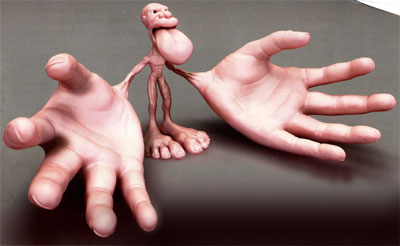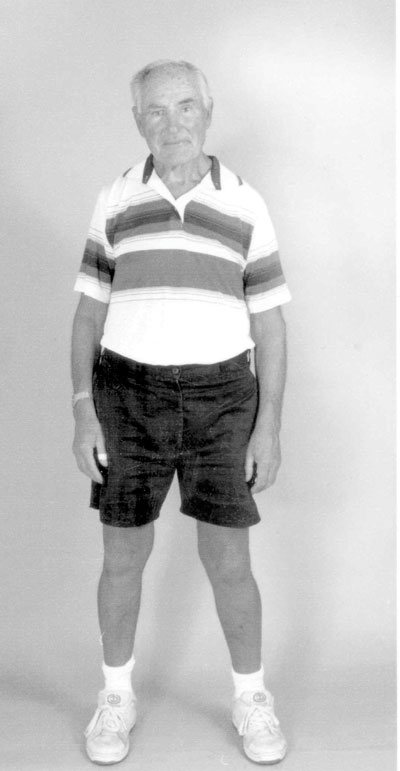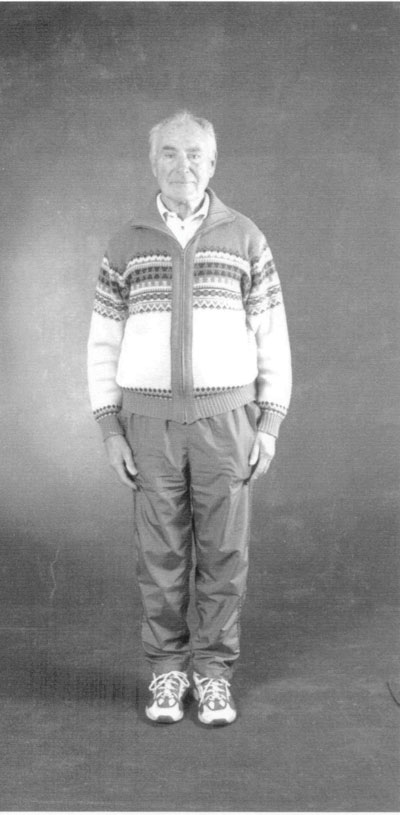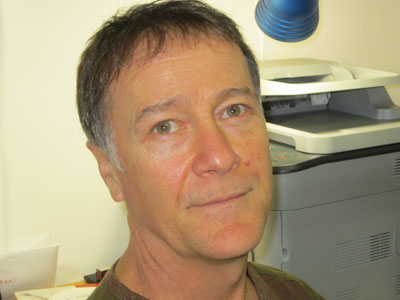
Features
Practice
Technique
Clinical Somatic Education, Part 2
Part 1 of this article concluded with a discussion about the somatic centre as a focal point for health, education and treatment.
April 13, 2012 By Andrew Teufel RMT
Part 1 of this article concluded with a discussion about the somatic centre as a focal point for health, education and treatment. In part 2, these concepts will be expanded on using a case study.
 |
|
| Figure 1 – The homunculus is the brain’s somatic representation of our body.
|
The somatic centre is at the spinal pelvic centrum – it has the largest muscle groups, contains the pivotal centre of gravity, and houses and protects the organs and the nervous system. One of the most important concepts of the somatic centre is that it has reduced sensory/motor feedback in comparison to other body parts. For most somatic educators, even if the pain is at the hands or feet, a great deal of consideration is given to “what the somatic centre is doing” to compensate.
Revisiting the homunculus
The ‘little man’ (English translation for the Latin term – “homunculus”) is the brain’s somatic representation of our body. (Figure 1) When we look at this, we see a true representation of the map of the brain for body consciousness and control (somatic nervous system). Originally mapped out by Dr. Wilder Penfield, this schematic shows the motor and sensory mapping of the cortex of the brain. “Examining the homunculus reveals the amount of brain power allocated to the thumb is greater than the entire pelvic region,” wrote Ray Long, MD, orthopedic surgeon and yoga educator. This is an important idea considering the multifaceted purposes of the somatic centre.
Case Study
Cliff (Figure 2) initially came to see me to get help with his chronic but quickly escalating neck pain. His neck and low back pain were escalating significantly and with less than three months before a trip that he was planning to England, Cliff thought he may have to change his plans and not go. A quick observation of Cliff’s body posture/alignment revealed distortions in the position of his head, spine, ribs and pelvis – all combining to create a rotoscoliosis.
 |
 |
| Figure 2 A – Cliff before he began clinical somatic education. His somatic centre has a great deal of imbalance. |
Figure 2 B – After treatment, Cliff has increased balance and flexibility, stands three inches taller and has greatly reduced his neck pain, which was his initial complaint. |
When we look at Cliff we can see an individual whose somatic centre has a great deal of imbalance. Cliff’s posture illustrates the three primary pulls that can distort the somatic centre: an overarched spine (landau reflex), forward head posture and rounded shoulders (startle reflex) and right tilt of the body (trauma reflex and hand/leg dominance). Cliff had several knee surgeries, more on his left knee. The right tilt and rotation of his torso reflects the autonomic response and patterning due to his chronic left knee pain.
Cliff underwent clinical somatic education and was able to eliminate his neck pain (original reason for seeing me) and other pain. He was also able to gain flexibility and ROM that were lost decades earlier and now stands three inches taller in four weeks – quite a feat at 79 years!
Cliff’s case study demonstrates the ability to retrain involuntary muscle contractions/tension through clinical somatic
education.
Clinical Somatic Education
Clinical somatic education consists of three parts:
- Self-study/self-knowledge/somatology – the study of any human science as it pertains to oneself;
- Manual somatics/applied somatics; and
- Somatic mat work.
Each of these three components acts to increase the therapeutic results that reduce pain and increase mobility.
Self-knowledge through somatology helps to increase the individual’s awareness of change. Manual somatics (applied somatics) heightens a person’s awareness but also accelerates the release of involuntary muscle tension that compresses and distorts the body. Somatic mat work allows the client to work at home to help self-release and to reinforce changes made after individual sessions of applied somatics.
Through these methods of education, the use of the practitioner’s hands, and through their own process at home on the mat, individuals can learn to help themselves along a path of positive body change. Clients report an increased awareness of unnecessary tension, ability to consciously relax tension, decreased levels of pain, increased flexibility, increased quality of sleep and an increase in the overall sense of well-being.
Self Study – Somatology
Registered massage therapists (RMTs) have a body of knowledge that they can impart/transfer to their clients to help facilitate self-learning and optimizing and maintaining long-term health. This transference of knowledge for self-study is essential for clinical somatic education to succeed.
Even though Cliff had amazing movement and fitness for his age, he had very little proprioceptive awareness and couldn’t see his postural changes that I tried to point out to him using a mirror. Like most people, teaching him to understand the primary reflexes that affect his somatic centre and other unconscious habits that contribute to his tension and imbalance was like turning on a light to help him see where he needed to create change. In Cliff’s situation, self-study (somatology) combined with his desire to keep moving, gave him quick changes in his pain levels and posture.
Cliff wasn’t aware that he put most of his weight on his right foot while his torso was tilting to the right. Teaching him to understand his left knee pain compensation helped him to understand how his body had automatically adjusted to avoid the knee pain. Cliff was also not aware that his spinal extension while standing upright was better than straight – the humeral head was posterior to the head of the trochanter by five inches. His posture is common in athletes, with spine pulled backward and ready to push forward. The hunched shoulders and head were something he was aware of because he could no longer lie supine on any surface without suffering serious neck pain and headaches. He was aware that he could not relax his shoulders and head down to any surface unless he had support under the head and shoulders.
Each meeting with Cliff involved a plan to safely approach re-educating his autonomic nervous system in order for his neuromuscular and postural patterns to change. The education about habitual muscle tension and postural patterns for self-study set the path for our meetings for applied somatics/manual somatics and somatic mat work.
Applied Somatics/ Manual Somatics
There are three primary hands-on techniques that clinical somatic educators use to facilitate greater release of the autonomic nervous system, reduce muscular tension and stretch the myofascial system. They are: pandiculation, kinetic mirroring, and lock-in.
Pandiculation is the primary tool that we will focus on in this article.
The term pandiculation comes from the field of animal behaviour and means “to stretch while yawning.” It is the activity you see in cats, dogs, humans when waking to release tension. According to a Canadian study in comparative pandiculation of animals, the self-stretching that animals do seems to be “for kinetic output and general comfort.” Hanna used the term pandiculation to describe the facilitated releases that are done with conscious participation from the client. This form of muscle energy activates the client’s participation and awareness/consciousness, versus forms of muscle energy that do not engage the consciousness of the client. Practitioners utilize their hands to facilitate the awareness and release of unconscious tension, similar to the self-pandiculating that animals do to stretch their bodies.
Cliff was seen for applied somatics sessions once per week over a period of four weeks. As well, he did somatic mat work between his appointments.
In the first session with Cliff, we used applied somatics/manual somatics with the abductors and adductors of the pelvis in order to create a balanced neutral position for the pelvis. For the second session, we focused on manual release of the right latissimus dorsi and oblique muscles that contributed to the compression of the right shoulder and ribcage in order to correct his tilting posture. In the third session we focused on his obliques, rectus abdominus, serratus anterior, pectoralis and sternocleidomastoid muscles to open the chest, rounded shoulders and forward head posture. In the fourth session we focused on his paraspinals to help Cliff to understand how long and relaxed they could be.
Somatic Mat Work/Self-release
Mat work can be taught to clients on the table, with movements specific to the needs of the client. In Cliff’s situation the mat exercises reinforced the applied somatics/manual somatics (pandiculations) done in individual sessions. The mat work is a form of self-pandiculation, similar to the movements that animals do to remain limber.
In the first session we taught Cliff the some targeted exercises and the horizontal component of walking to release his abductors and adductors of the pelvis. In the second session Cliff learned shoulder clockwork and the appropriate exercises, to release the oblique and latissimus dorsi to release the tilt and leg length difference. In the third session we taught him arch-and-flatten and arch-and-curl – floor exercises aimed at helping him lengthen and relax the paraspinal and abdominal muscles. In the final session we instructed Cliff to learn a simple extension movement to increase his awareness to being able to voluntarily release his extensors – this movement involves extension and rotation of the spine.
Somatics Integrated with Massage Therapy
Somatics offers a functional model for the approach to pain, posture and myofascial-osseus health issues. The functional model that we express to our clients is the hierarchy of consciousness. Its progression is:
- bone is a servant of the myofascial system;
- the myofascial system is a servant of the brain/CNS; and
- the brain has two paths for the control of the myofascial system – somatic/conscious control and/or autonomic/unconscious control.
The somatic control can reset and reduce the autonomic myofascial-osseus tension from the pain/tension cycle, habitual patterns of tension from hand use, standing/sitting, and the tension and stress response from the startle reflex, which is overstimulated in today’s society.
Somatics fits well into an RMT practice because it is easy to use by both practitioner and client. RMTs are accustomed to having the client on the table lying down. About 75 per cent of somatic exercise (to be done on a mat at home) and education is done lying down to reduce/change the autonomic/habitual/myo-osseus tension patterns. About 90 per cent of the applied somatics/manual somatics is done lying down for the same reasons stated.
Finally, engaging our client’s awareness in education and participation means engaging self-care, self-release, self-improvement and self-assessment of their body in everyday life.
 |
Andrew Teufel has been an RMT for 20 years. He is certified from the Novato Institute for Somatic Research and Training, a Yoga teacher and a former RN. He has been providing continuing education for RMTs in somatics since 1997 and is the creator of Applied Somatics and Applied Somatics Institute. Andrew is a presenter and consultant to private and public businesses and groups.
Print this page